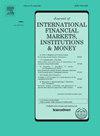Stablecoins as anchors? Unraveling information flow dynamics between pegged and unpegged crypto-assets and fiat currencies
IF 6.1
2区 经济学
Q1 BUSINESS, FINANCE
Journal of International Financial Markets Institutions & Money
Pub Date : 2025-01-06
DOI:10.1016/j.intfin.2024.102108
引用次数: 0
Abstract
This study empirically investigates the potential of stablecoins to act as anchors within the volatile cryptocurrency market, using a novel conceptual framework that defines an anchor asset in three dimensions relative to other assets, namely stability, independence, and resilience. To assess these three dimensions, we employ three distinct methods to analyze the linear and nonlinear relationships between stablecoins (Tether, USD Coin, and Binance USD), the top three unpegged crypto-assets (Bitcoin, Ethereum, and Binance), and the three most heavily traded fiat currencies after the US dollar (EUR, JPY, and GBP), all denominated in USD. Specifically, we utilize Granger causality, asymmetric dynamic conditional correlation (ADCC)-GARCH, and transfer entropy approaches. These methods help us examine volatility spillover effects among the three types of assets. Our resilience criteria requires us to measure market liquidity, which we do by employing the turnover ratio weighted by market capitalization and the approach proposed by Abdi and Ranaldo (2017). The results challenge the notion that stablecoins are robust anchors in the sense that they are more stable, independent, or resilient than other types of assets, and cast doubt on the suggestion that stablecoins might become a useful means of exchange that provide a private alternative to existing fiat currencies.
稳定币作为锚?解开挂钩和非挂钩加密资产与法定货币之间的信息流动态
本研究实证研究了稳定币在波动的加密货币市场中充当锚点的潜力,使用了一个新的概念框架,该框架从相对于其他资产的三个维度定义了锚点资产,即稳定性、独立性和弹性。为了评估这三个维度,我们采用三种不同的方法来分析稳定币(Tether, USD Coin和Binance USD),前三大不挂钩的加密资产(比特币,以太坊和Binance)以及美元之后交易量最大的三种法定货币(欧元,日元和英镑)之间的线性和非线性关系,所有这些都以美元计价。具体来说,我们利用格兰杰因果关系、不对称动态条件相关(ADCC)-GARCH和传递熵方法。这些方法有助于我们检验三种资产之间的波动溢出效应。我们的弹性标准要求我们衡量市场流动性,我们通过采用市值加权的换手率和Abdi和Ranaldo(2017)提出的方法来做到这一点。研究结果挑战了稳定币是稳健锚的观点,因为它们比其他类型的资产更稳定、更独立或更有弹性,并对稳定币可能成为一种有用的交换手段、为现有法定货币提供私人替代方案的说法提出了质疑。
本文章由计算机程序翻译,如有差异,请以英文原文为准。
求助全文
约1分钟内获得全文
求助全文
来源期刊
CiteScore
6.60
自引率
10.00%
发文量
142
期刊介绍:
International trade, financing and investments, and the related cash and credit transactions, have grown at an extremely rapid pace in recent years. The international monetary system has continued to evolve to accommodate the need for foreign-currency denominated transactions and in the process has provided opportunities for its ongoing observation and study. The purpose of the Journal of International Financial Markets, Institutions & Money is to publish rigorous, original articles dealing with the international aspects of financial markets, institutions and money. Theoretical/conceptual and empirical papers providing meaningful insights into the subject areas will be considered. The following topic areas, although not exhaustive, are representative of the coverage in this Journal. • International financial markets • International securities markets • Foreign exchange markets • Eurocurrency markets • International syndications • Term structures of Eurocurrency rates • Determination of exchange rates • Information, speculation and parity • Forward rates and swaps • International payment mechanisms • International commercial banking; • International investment banking • Central bank intervention • International monetary systems • Balance of payments.

 求助内容:
求助内容: 应助结果提醒方式:
应助结果提醒方式:


